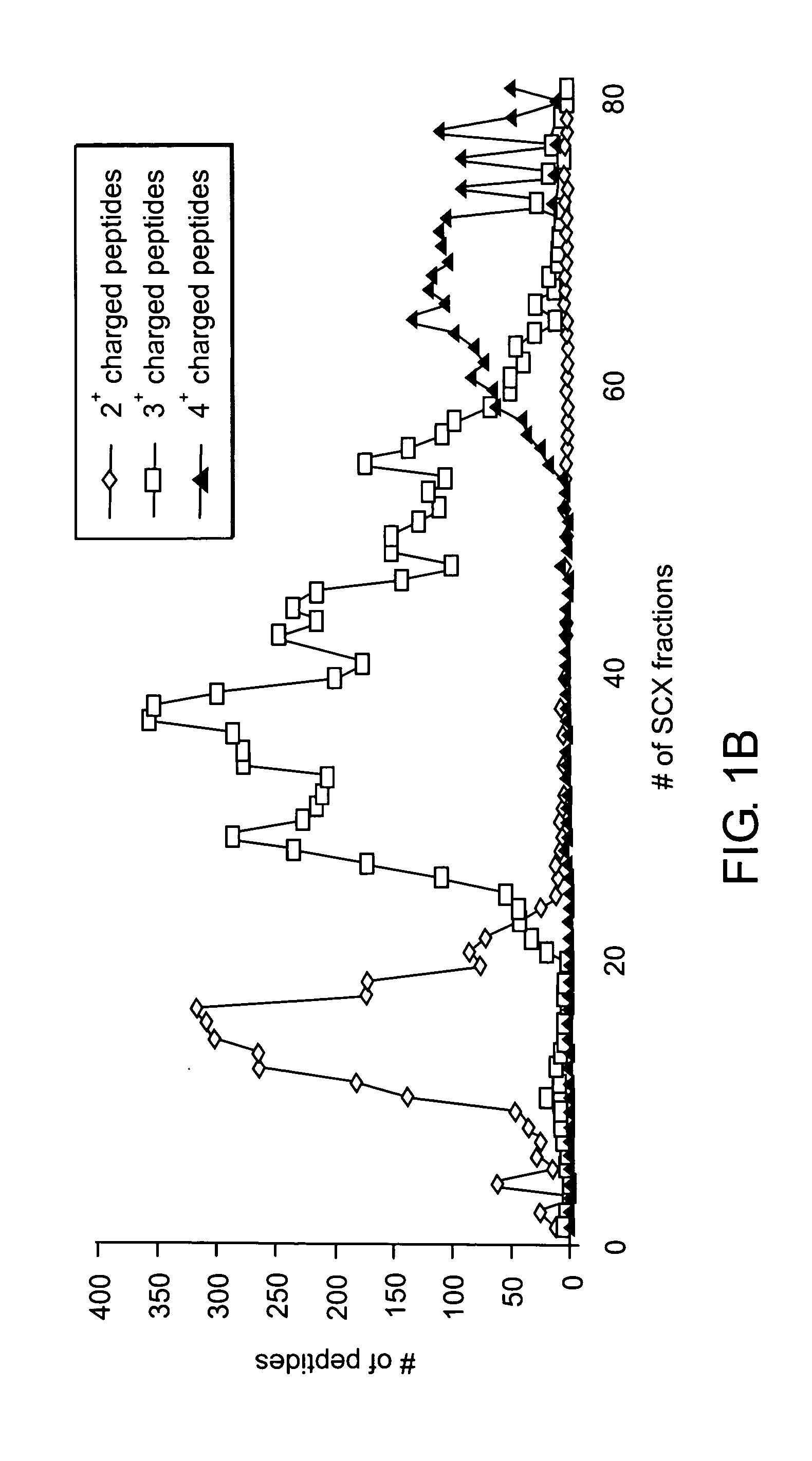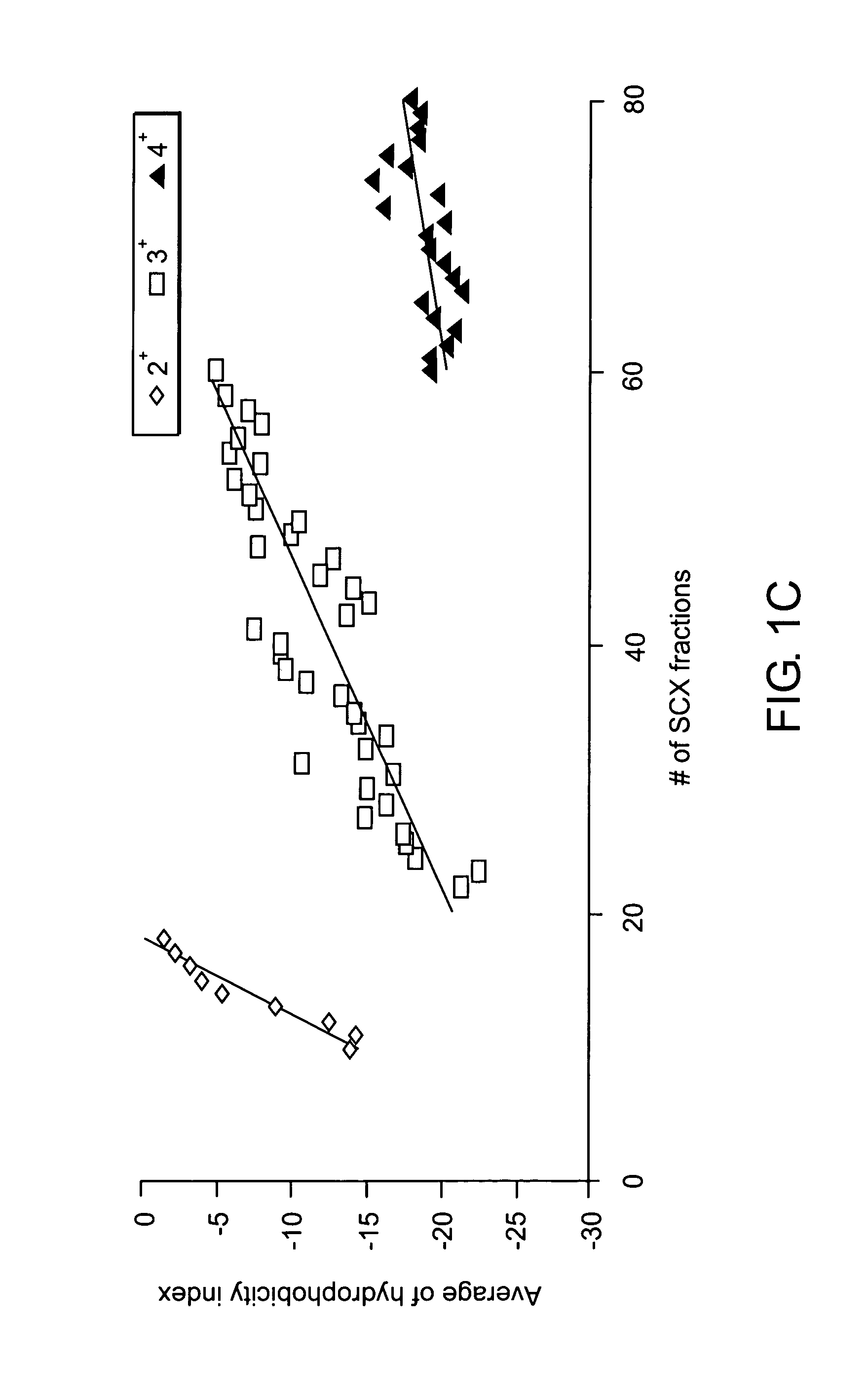Systems, methods and kits for characterizing phosphoproteomes
a technology of phosphoproteome and system, applied in the field of systems, software and kits for characterizing phosphoproteome, can solve the problems of complex identification of phosphorylation sites on proteins, unsolved large-scale identification and characterization problems, and inability to provide information regarding post-translational modifications of proteins, so as to facilitate the development of improved diagnostics and quickly screen for alterations in the phosphorylation state of proteins
- Summary
- Abstract
- Description
- Claims
- Application Information
AI Technical Summary
Benefits of technology
Problems solved by technology
Method used
Image
Examples
example 1
[0187] Tandem mass spectrometry (MS / MS) provides the means to determine the amino acid sequence identity of peptides directly from complex mixtures (Peng and Gygi, J. Mass Spectrometry 36: 1083-1091, 2001). In addition, the precise sites of modifications (e.g., acetylation, phosphorylation, etc.) to amino acid residues within the peptide sequence can be determined.
[0188] Organelle-specific proteomics provides the ability to i) more comprehensively determine the components by enriching for proteins of lower abundance, ii) study mature (fuinctional) protein, and iii) evaluate proteomics within the boundaries of cellular compartmentalization. In the present example, the isolation, separation, and large-scale amino acid sequence analysis of the HeLa cell nucleus is described. Nuclear proteins were separated by preparative SDS-PAGE. Twenty gel slices were proteolyzed with trypsin and separated by off-line strong cation exchange (SCX) chromatography and fraction collection. Each fraction...
example 2
[0194] In this experiment, the characterization of phosphoproteins from asynchronous HeLa cells was performed. Because of the complexity of the sample, the proteins present in a nuclear fraction were examined and a preparative SDS-PAGE separation was applied to allow milligram quantities of starting protein (FIG. 6A). The entire gel was excised into 10 regions and proteolyzed with trypsin followed by phosphopeptide enrichment by SCX chromatography. Early-eluting fractions were subjected to further analysis by reverse-phase liquid chromatography with on-line sequence analysis by tandem mass spectrometry (LC-MS / MS).
[0195] More than 12,000 MS3 spectra were also acquired during the course of the experiment and used to help compliment database searches and manual interpretation of phosphorylation sites.
[0196] In total, 2,002 different phosphorylation sites were identified by the Sequest algorithm and each site was manually confirmed using in-house software by three different people. Ma...
example 3
Determining N-terminal Sequences And N-terminal Modifications Of Proteins From Saccharomyces cerevisiae On A Large Scale
[0214]S. cerevisiae strain S288C was grown on YPD-medium (Becton and Dickinson) at 30° C. to midlog phase (OD600 of 1). Approximately 3×109 cells were harvested by centrifugation and the cell-pellet was resuspended in lysis buffer (50 mM Tris-HCl, pH 7.6, 0.1% SDS, 5 mM EDTA, and a protease inhibitor cocktail: 2 μg / ml aprotinin; 10 μg / ml leupeptin, soybean trypsin inhibitor, and pepstatin; 175 μg / ml phenylmethylsulfonyl fluoride) and lysed using a French press. About 1 mg proteins from the obtained yeast whole cell lysate were separated on a 12% SDS-PAGE gel. The gel was cut into 5 slices and the proteins were in-gel modified as described in the following: reduction with 10 mM DTT (pH 8.0) at 56° C., alkylation of Cys-residues with 55 mM iodoacetamide (pH 8.0) at RT in the dark, and d3-acetylation of unblocked amino groups with 50 mM NH4HCO3 (pH 8.0) / MeOH / d6-aceti...
PUM
| Property | Measurement | Unit |
|---|---|---|
| pH | aaaaa | aaaaa |
| mass | aaaaa | aaaaa |
| pH | aaaaa | aaaaa |
Abstract
Description
Claims
Application Information
 Login to View More
Login to View More - R&D
- Intellectual Property
- Life Sciences
- Materials
- Tech Scout
- Unparalleled Data Quality
- Higher Quality Content
- 60% Fewer Hallucinations
Browse by: Latest US Patents, China's latest patents, Technical Efficacy Thesaurus, Application Domain, Technology Topic, Popular Technical Reports.
© 2025 PatSnap. All rights reserved.Legal|Privacy policy|Modern Slavery Act Transparency Statement|Sitemap|About US| Contact US: help@patsnap.com



